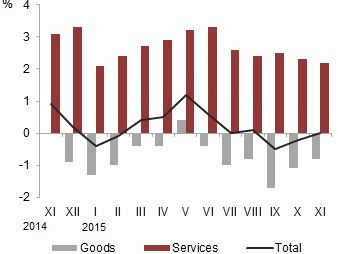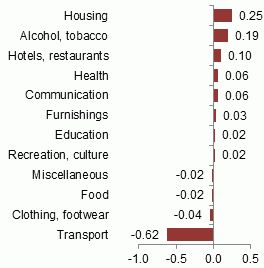Analytics, Inflation, Latvia, Markets and Companies
International Internet Magazine. Baltic States news & analytics
Friday, 19.04.2024, 17:23
During the year, the average level of consumer prices in November in Latvia didn’t change
 Print version
Print version
Compared to the previous 12 months, the average consumer price level over the last 12 months2, grew by 0.2%.
 |
| Changes in consumer prices in 2014 and 2015 (% over the corresponding month of the previous year) |
Data source: Central Statistical Bureau of Latvia
The greatest pressure on the average level of consumer prices in November 2015, as compared to November 2014, was put by increase in prices of goods and services related to housing, alcoholic beverages and tobacco, hotel and restaurant services, as well as by decrease in prices of transport goods and services.
The average food price level in November 2015 as compared to the corresponding month of the previous year decreased by 0.1%. Milk and dairy products, cheese, meat and meat products, oils and fats had the most significant lowering impact on the price level. In turn, prices of vegetables, fruit witnessed growth.
 |
| Commodity group impact on Consumer Price Index during the last 12 months (percentage points) |
The average price level of alcoholic beverages grew by 3.0% which was significantly affected by increase in prices of beer and spirits. Prices of tobacco rose by 1.2%.
During the year prices of goods and services related to housing increased by 1.5%. Growth was recorded in prices of electricity, maintenance charges in multi-occupied buildings, refuse collection; in turn, drop was observed in prices of heat energy and natural gas.
In transport group the average price level declined by 4.6%, which was significantly affected by drop of 15.8% in prices of fuels for transport. Decrease was recorded in prices of passenger transport by air; in turn, increase was observed in services of passenger transport by railway and road, maintenance and repair services of personal transport equipment.
Compared to November of the previous year prices of hotel and restaurant services witnessed growth. Prices in cafés and restaurants increased by 2.8%, and in canteens – by 2.4%. During the year the average price level of hotel services decreased by 5.3%.
Among other consumption groups, the most significant growth was recorded in prices of telecommunication services, pharmaceutical products; in turn, decrease was observed in prices of hospital services and package holidays.
As compared to the previous month the average level of consumer prices in November 2015 did not change. Prices of goods increased by 0.1%, while prices of services declined by 0.2%.
The greatest pressure on consumer price changes in November was put by growth in prices of food and non-alcoholic beverages, as well as by drop in prices of clothing and footwear, transport goods and services, recreation and culture, furnishings.
Over the month prices of food grew by 0.7%. Growth of 12.4% in prices of vegetables, with the greatest increase in the prices of cucumbers, tomatoes and sweet peppers, had the most significant impact on the price level changes within the food group. Growth was also recorded in prices of bread and cereals, milk and dairy products, fruit, sugar. In turn, cheese, ground coffee, meat and meat products, eggs, potatoes became cheaper.
Prices of footwear dropped by 2.2% and of clothing – by 0.7%.
Affected by discounts, prices of non-durable household goods decreased by 2.6%. Also household textiles became cheaper.
In transport group the average price level declined by 0.3%, which was mainly affected by decrease of 0.7% in prices of fuels for transport. Services of passenger transport by sea and of passenger transport by road became cheaper; in turn, prices of spare parts and accessories for personal transport equipment witnessed growth.
In recreation and culture group prices declined on average by 0.4%, which was mainly affected by drop in prices of package holidays. The average price level of books also decreased; in turn, flowers became more expensive.
Among other consumption groups, the most significant growth was recorded in prices of telecommunication services, wine, maintenance charges in multi-occupied buildings and tobacco. Decrease was observed in prices of individual care goods, beer.
Consumer price changes by commodity group, %
|
Commodity group |
Price changes in November 2015, compared to |
||
|
November 2014 |
December 2014 |
October 2015 |
|
|
Total |
0.0 |
0.7 |
0.0 |
|
Food |
-0.1 |
0.0 |
0.7 |
|
Alcohol, tobacco |
2.3 |
3.2 |
0.1 |
|
Clothing, footwear |
-0.6 |
2.7 |
-1.1 |
|
Housing |
1.5 |
1.8 |
0.0 |
|
Furnishings |
0.7 |
0.6 |
-0.6 |
|
Health |
1.1 |
0.8 |
0.1 |
|
Transport |
-4.6 |
-2.3 |
-0.3 |
|
Communication |
1.7 |
1.9 |
0.3 |
|
Recreation, culture |
0.2 |
0.0 |
-0.4 |
|
Education |
1.5 |
1.6 |
0.0 |
|
Hotels, restaurants |
2.4 |
2.5 |
-0.1 |
|
Miscellaneous |
-0.4 |
-0.1 |
-0.5 |
Sub-indices having the greatest impact, percentage points
|
During the month |
|
|
Vegetables |
0.16 |
|
Bread and cereals |
0.05 |
|
Garden products and flowers |
0.03 |
|
Individual care goods |
-0.03 |
|
Non-durable household goods |
-0.03 |
|
Fuels for transport |
-0.04 |
|
Footwear |
-0.04 |
|
Package holidays |
-0.05 |
|
During 12 months |
|
|
Electricity |
0.87 |
|
Services of passenger transport by road |
0.20 |
|
Beer |
0.13 |
|
Catering services |
0.11 |
|
Gas |
-0.12 |
|
Milk and dairy products |
-0.17 |
|
Heat energy |
-0.57 |
|
Fuels for transport |
-0.95 |
Information on Consumer Price Index in December 2015 will be published on 12 January 2016.
More detailed information on consumer price changes is available in the CSB database section Consumer Prices.
1 The annual inflation characterises consumer prices changes
comparing the average price level in the reference month with the average price
level in the corresponding month of the previous year.
2 The average annual inflation characterises the average consumer
price level of the last 12 months in comparison with the average consumer price
level in 12 months of the previous year. This indicator is mainly used for
macroeconomic analysis, investigating inflation processes over a longer time
period, since it is practically not affected by short-term or temporary price
fluctuations.








 «The Baltic Course» Is Sold and Stays in Business!
«The Baltic Course» Is Sold and Stays in Business!

